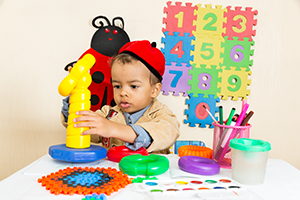Early Childhood Environments: Designing Effective Classrooms
Wrap Up
 Teachers often have a difficult time knowing how to create classroom environments that support the learning and development of the children in their care. However, developing well-designed classrooms is important because these environments:
Teachers often have a difficult time knowing how to create classroom environments that support the learning and development of the children in their care. However, developing well-designed classrooms is important because these environments:
- Help provide safety
- Support responsive caregiving
- Foster independence and feelings of competence in young children
- Encourage staff efficiency
- Decrease challenging behavior
- Facilitate appropriate social interactions among children
- Provide structure and predictability
When teachers think of the classroom environment, they tend to think primarily of its physical aspects. However, teachers should also pay attention to the social and temporal environments. It is the integration of all three (see the table below) that contribute to a well-designed classroom for young children.
| Components of Early Childhood Environments | Definition |
| Physical environment | The overall design and layout of a room, including its learning centers, materials, and furnishings |
| Social environment | The interactions that occur within the classroom between peers, teachers, and family members |
| Temporal environment | The timing, sequence, and length of routines and activities that take place throughout the day |
Infants and young toddlers often have special learning considerations that teachers need to consider when designing an environment to support their development and needs. Further, teachers should keep in mind that some children with disabilities might need more support than the environment provides. In these cases, teachers need to make changes that will maximize the children’s participation in the classroom’s ongoing routines, interactions, and activities.
Revisiting Initial Thoughts
Think back to your initial responses to the following questions. After working through the resources in this module, do you still agree with your Initial Thoughts? If not, what aspects of your answers would you change?
What elements make up a well-designed early childhood environment?
What can teachers do to make the classroom environment more conducive to children’s learning and development?
When you are ready, proceed to the Assessment section.